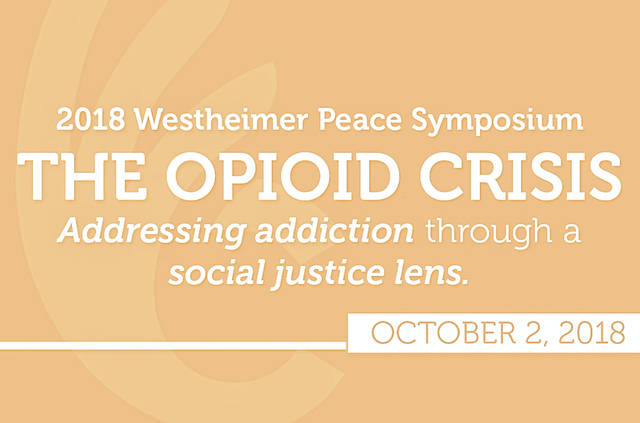
WILMINGTON — Since 2016, Ohio has been ranked second in the nation for most overdose deaths from opioids.
Wilmington College will join together with area communities Oct. 2 in an effort to better understand this high rate of death through the 28th Westheimer Peace Symposium.
The annual daylong program will look at the opioid crisis from a social justice perspective. It will consider how issues, such as low-paying jobs and lack of availability of social services in Ohio, relate to spikes in incarceration. The program also will examine the racial aspects of addiction responses.
“The Opioid Crisis: Addressing Addition through a Social Justice Lens” will be bookended by a pair of keynote addresses in Heiland Theatre with three afternoon panel discussions in the McCoy Room of Kelly Center.
All events are free of charge.
Law professor Ekow Yankah will open the symposium with a 10 a.m. address on “Addiction, Race and Social Bonds: A History of Law Enforcement in America.” He is a faculty member with Cardozo Law School at Yeshiva University in New York.
Yankah will examine the historical context of how the justice system in the United States has responded to addiction over time. In particular, he will focus on the judicial and social responses to the crack/cocaine epidemic of the 1980s and 90s, and compare it to the current responses to the opioid crisis.
Clifford Cabansag, M.D., an addiction medicine physician, will present the closing keynote, at 7 p.m., on “The Worsening Opioid Crisis: Where Did We Go Wrong?” He will focus on the need for adequate treatment of opioid addiction. In particular, he will address the disparities between how we address known diseases such as cancer versus the disease of addiction.
A certified addiction specialist with the Lindner Center of HOPE, Cabansag specializes in several areas of therapy, including Rational Emotive Behavioral Therapy, Self-Management and Recovery Training, Relapse Prevention, Cognitive Behavioral Therapy and Motivational Interviewing.
The day is chock full of activities between the opening and closing keynotes.
At 11 a.m., a unique combination of visual arts, dance and live testimonials will be held in the Meriam R. Hare Quaker Heritage Center. Featured will be a poster exhibit highlighting the current state of Ohio’s opioid crisis through statistical data and personal stories, along with orally presented testimonials complemented by dance movements from members of All That Dance studio in Springboro.
During the lunch hour, beginning at noon, an activity called “HealthRHYTHMS” will be held in Dining Rooms C&D in Pyle Student Center. The audience can purchase their lunch and dine while learning how patients in addiction rehabilitation use a special collection of percussion instruments to relieve their stress, improve anger management skills and create a team-oriented environment.
The first of three panel discussions, titled “Science of Opioid Addiction,” will commence at 1 p.m. in the McCoy Room.
This panel will explore the neurology of opioid dependence by discussing how opioids change the brain in ways that undermine individual attempts at recovery. The panel will also consider current pharmaceutical and therapeutic treatments intended to address the biological changes that have taken place.
Panelists include: Michael Newman, M.D., medical coordinator for the You-Turn Recovery Docket program at Clinton County Common Pleas Court; Chris Wyatt, Ph.D., professor of neuroscience, physiology and cell biology at Wright State University; and Chris Tuell, Ed.D., licensed professional clinical counselor and licensed independent chemical dependency counselor at Lindner Center of HOPE.
The second panel discussion, “Addressing the Crisis through Activism and Art, will begin at 2:30 p.m. in the McCoy Room and feature Kevin O’Donnell, a grassroots activist and organizer with the Ohio Students Assn.; Elizabeth Hopkins, AMOS Project; and Jes McMillan, a collaborative artist with The Mosaic Institute of Greater Dayton.
This panel will consider the work that artists and activists are doing to raise awareness about the opioid crisis — from McMillan’s “Wall of Perseverance” project in West Dayton to the work of activists to realize Ohio’s ballot Issue No. 1.
The third panel discussion, at 4 p.m., in the McCoy Room, will look at “Judicial and Rehabilitative Responses” and feature Taylor Bennett, director of advocacy with Harm Reduction; John W. Rudduck, judge, Clinton County Common Pleas Court and William Kennedy, Doctor of Clinical Psychology, Kennedy Consulting and Training; and Lee Sandlin of Sugartree Ministries.
This panel will examine judicial and rehabilitative responses to the opioid crisis including the Clinton County Drug Court and other local organizations that are responding to the crisis. In particular, the panel will consider the appropriateness of incarceration versus treatment.


